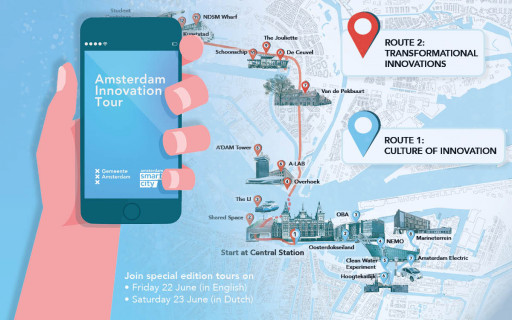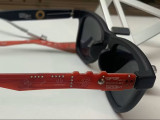Those with an interest in urban innovation topics can now discover what makes Amsterdam an innovative, smart city without the timing and logistical constraints of a guided tour. The new self-guided Amsterdam Innovation Tour enables local and international stakeholders to immerse themselves in learning about the City’s innovative projects at any time — day or night.
Amsterdam Innovation Tour

What is the goal of the project?
In any given year, The City of Amsterdam and Amsterdam Smart City (ASC) receive hundreds of requests from local, national and international delegations interested in visiting and learning about Amsterdam’s urban innovations and smart city projects. In the face of rising demand, there was interest in developing a self-guided tour that could facilitate knowledge transfer and increase impact in a cost-effective manner.
What is the result of the project?
The Amsterdam Innovation Tour app was officially launched in June 2018 by Touria Meliani, Amsterdam’s Vice-Mayor of Culture & Digital during the Next Generation Cities conference, part of the We Make The City innovation festival.
Two self-guided walking routes were developed, both starting from Central Station.
For the first two months, a pilot was carried out whereby participants could begin their tour by activating a video-message on a JCDecaux digital screen.
The app is available in the Apple Store and Google Play.
Who initiated the project and which organizations are involved?
The project was launched by the City of Amsterdam Chief Technology Office and Amsterdam Smart City. Following an open call for proposals on the Amsterdam Smart City platform, which resulted in fourteen submissions, Bureau Design Digitale Zaken (BDDZ) and Moqod were selected to develop an app-based innovation tour. Other project partners include JC Decaux, Brandijzers and Lucas Brailsford Design Studio.
What is the next step?
The next steps are to develop audio and video content and enhance the AR functionalities.
What can other cities learn from your project?
The main lessons learned are:
- The use of the JC Decaux interactive screen to show user-activated content at Central Station was the most successful and well-received part of this project. This feature attracted attention from passers-by who wanted to know what was happening and interact with the large screen. These screens present a unique opportunity for engagement with broad audiences on a variety of topics.
- Relevant stakeholders are reluctant to communicate their smart city project, for example those related to crowd management and the City’s beacons network, as some of these topics are deemed sensitive. This made it difficult to collect relevant and inspiring content. To circumvent this challenge, the Innovation Tour could be linked to “fuckup” events where stakeholders are asked to share project success and failures which will also be incorporated in the tour.
- One main ambition for the project was to illustrate innovations unseen to the eye using innovative AR features. This ambition of “making the unseen, seen” could not be achieved due to limitations in content (securing relevant 3D models, visualizations, etc.) and technical capabilities.
- For students and innovation tourists a self-guided tour can be interesting but for professional delegates traveling great distances to connect to relevant expertise, the interest is in meeting with relevant experts so a self-guided tour is not satisfactory.
- When evaluating technology providers, place more emphasis on the option offering user-friendly Content Management System (CMS). This will make updating content easier and more affordable.
Do you have ideas or suggestions for how to improve the Innovation Tour? Share your feedback or experience on similar projects in the Discussion section or email innovationtour@amsterdamsmartcity.com.




